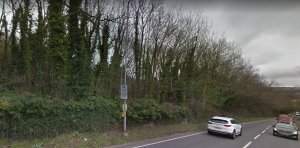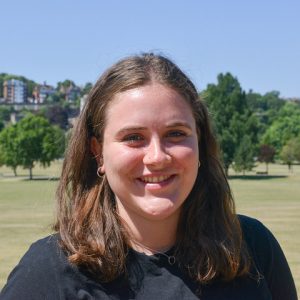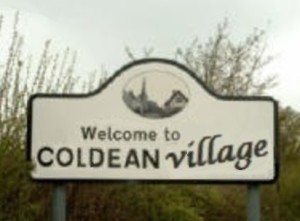About 50 trees in Coldean woods need to be removed after the discovery of a large outbreak of elm disease in the area, according to Brighton and Hove City Council.
The council said today (Friday 30 July) that work to remove the trees would start next Wednesday (4 August) and was expected to take three to five days.
It is a huge loss to the city’s National Elm Collection, the council said, adding: “Elm disease can spread very quickly so the removal of infected needs to be done as quickly as possible to control the infection spreading further to neighbouring trees.
“The trees are on and around the site of the Homes for Brighton and Hove low-cost housing development in Coldean Lane. The infection was found during a visit to the site by the council’s arboricultural team.
“The tree-felling will be carried out to Natural England guidelines, with a qualified ecologist on site to supervise the work and minimise any disturbance to wildlife.
“There are badger setts within the woodland affected. This caused a slight delay while ecologists were consulted to make sure all measures were in place to protect badgers.
“Ecologists have been monitoring the badger activity in the area over the last 18 months as part of the wildlife protection measures for the housing development.
“The setts in the area affected have been closely monitored in line with Natural England guidance, including use of thermal imaging technology.
“There are no signs of recent use and steps will be taken to ensure badgers do not start re-using the sets to protect them during the development.
“This will be done under licence from Natural England and needs to be agreed with the council’s planning team and the county ecologist.
“The tree contractor working on the site will carry out the work to remove the infected elm as part of our elm control programme.
“Our arboricultural team will be on site to supervise all the work to make sure all disease control measures are in place.
“The removed elm will be taken to our licensed elm timber disposal site at Waterhall Road, with smaller material chipped and left on site.
“A small number of other trees may need to be removed in the area to allow access to remove the infected trees in a safe and controlled way. We will avoid this where at all possible.

“While most of the trees are towards the further end of the site, we’ll need to close one lane of the road so the trees near Coldean Lane can be removed safely.
“Traffic lights will be in place from Wednesday 4 August while work takes place.
“The woodland along Coldean Lane is an ongoing management issue and we anticipate more trees will need felling in the area over the next year.
“The elm disease could spread via root contact to other elms in the woods and, by next year, there will be a need to remove further ash trees infected with ash dieback.
“Once building work is complete on the Coldean Lane site, around 200 ‘early mature’ trees will be planted on the site as part of the woodland management and landscaping of the area. This will include 40 ‘disease resistant’ elms.
“Replanting in other areas of Coldean Woods will take place once the work to remove infected ash trees in danger of falling on to nearby paths is complete.”

Councillor Amy Heley, who chairs the council’s Environment, Transport and Sustainability Committee, said: “This is devastating news and we are very sorry about the further loss of trees in a woodland so recently affected by ash dieback.
“It’s very important to remove these infected elms as quickly as possible to protect the other elms in the area as much as possible.
“It’s some consolation that 200 new trees, including 40 elms, will be planted as part of the development of new low-cost housing on the site.
“The control of elm disease is an ongoing tree management issue in the city.
“Thanks to the brilliant work of our arboricultural team, we have a long and successful history of protecting elms in Brighton and Hove, and hold the National Elm Collection.
“We’ve lost a number of important elms to elm disease over recent years and to lose 50 in one go is terrible.
“You can help control elm disease by reporting dying elms to our arboricultural team. We will also inspect firewood and timber free of charge to remove any potentially infected elm logs.”

The council added: “The elm still remains the dominant tree throughout the city, with an estimated growing population of over 17,000 trees.
“Our success has led to the city becoming the holder of the National Elm Collection.
“Every summer, our arboricultural team wages a battle across the city against the tiny beetle which carries the deadly elm tree killing fungus known as elm disease or Dutch elm disease.
“Losses of trees to the disease have been manageable over the years thanks to a council-led control campaign.
“However, the city has seen several of its most significant and stunning elms fall victim to elm disease over recent years.
“One of the most likely ways for a tree to become infected by elm disease is via beetles breeding on elm logs stored in the area.
“These logs may have been brought in from other parts of Sussex where there has been a massive rise in trees becoming infected and subsequent logs becoming available.
“In recent years, there has also been a rapid increase in the number of wood burning stoves being sold in the area, increasing the risk of contaminated wood coming into the city.
“The council’s arboricultural team offers a free inspection of firewood and other timber.
“Similarly, if you have an elm tree in your garden that may be dead or dying, we are happy to come out and inspect it free of charge.
“Anyone wanting to use the service can contact the team by emailing arboriculture@brighton-hove.










